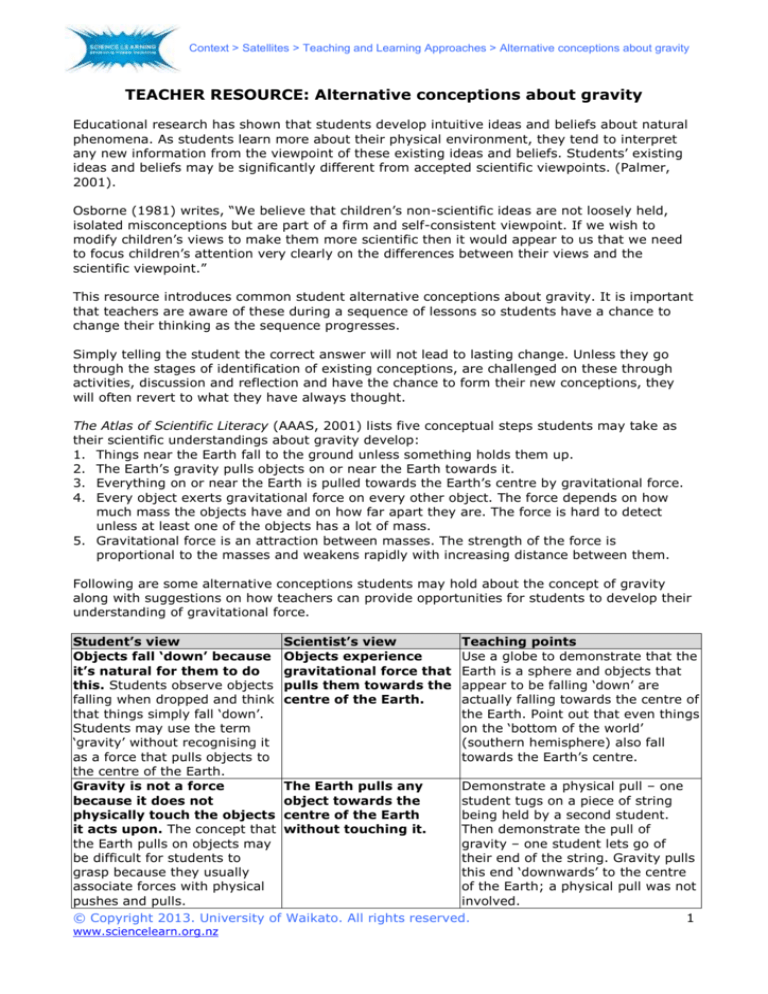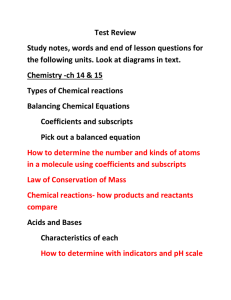
Context > Satellites > Teaching and Learning Approaches > Alternative conceptions about gravity
TEACHER RESOURCE: Alternative conceptions about gravity
Educational research has shown that students develop intuitive ideas and beliefs about natural
phenomena. As students learn more about their physical environment, they tend to interpret
any new information from the viewpoint of these existing ideas and beliefs. Students’ existing
ideas and beliefs may be significantly different from accepted scientific viewpoints. (Palmer,
2001).
Osborne (1981) writes, “We believe that children’s non-scientific ideas are not loosely held,
isolated misconceptions but are part of a firm and self-consistent viewpoint. If we wish to
modify children’s views to make them more scientific then it would appear to us that we need
to focus children’s attention very clearly on the differences between their views and the
scientific viewpoint.”
This resource introduces common student alternative conceptions about gravity. It is important
that teachers are aware of these during a sequence of lessons so students have a chance to
change their thinking as the sequence progresses.
Simply telling the student the correct answer will not lead to lasting change. Unless they go
through the stages of identification of existing conceptions, are challenged on these through
activities, discussion and reflection and have the chance to form their new conceptions, they
will often revert to what they have always thought.
The Atlas of Scientific Literacy (AAAS, 2001) lists five conceptual steps students may take as
their scientific understandings about gravity develop:
1. Things near the Earth fall to the ground unless something holds them up.
2. The Earth’s gravity pulls objects on or near the Earth towards it.
3. Everything on or near the Earth is pulled towards the Earth’s centre by gravitational force.
4. Every object exerts gravitational force on every other object. The force depends on how
much mass the objects have and on how far apart they are. The force is hard to detect
unless at least one of the objects has a lot of mass.
5. Gravitational force is an attraction between masses. The strength of the force is
proportional to the masses and weakens rapidly with increasing distance between them.
Following are some alternative conceptions students may hold about the concept of gravity
along with suggestions on how teachers can provide opportunities for students to develop their
understanding of gravitational force.
Student’s view
Scientist’s view
Teaching points
Objects fall ‘down’ because Objects experience
Use a globe to demonstrate that the
it’s natural for them to do
gravitational force that Earth is a sphere and objects that
this. Students observe objects pulls them towards the appear to be falling ‘down’ are
falling when dropped and think centre of the Earth.
actually falling towards the centre of
that things simply fall ‘down’.
the Earth. Point out that even things
Students may use the term
on the ‘bottom of the world’
‘gravity’ without recognising it
(southern hemisphere) also fall
as a force that pulls objects to
towards the Earth’s centre.
the centre of the Earth.
Gravity is not a force
The Earth pulls any
Demonstrate a physical pull – one
because it does not
object towards the
student tugs on a piece of string
physically touch the objects centre of the Earth
being held by a second student.
it acts upon. The concept that without touching it.
Then demonstrate the pull of
the Earth pulls on objects may
gravity – one student lets go of
be difficult for students to
their end of the string. Gravity pulls
grasp because they usually
this end ‘downwards’ to the centre
associate forces with physical
of the Earth; a physical pull was not
pushes and pulls.
involved.
1
© Copyright 2013. University of Waikato. All rights reserved.
www.sciencelearn.org.nz
Context > Satellites > Teaching and Learning Approaches > Alternative conceptions about gravity
Students may consider
Gravity is a type of
gravity to be a ‘thing’ rather interactive force
than a force. Again, students between objects.
are probably aware of and use
the term ‘gravity’ in
appropriate contexts without
recognising its scientific
meaning.
Gravity only acts on falling
objects. Students may be
unaware that gravity acts on
objects continuously. They may
think that gravity acts on an
object while it is falling but
then stops when it reaches the
ground.
Gravity only exists on the
Earth or its surface. Students
may think that there is no
gravity away from the Earth –
weightlessness occurs in all of
outer space. Students may also
think that gravity exists due to
the presence of air or the
Earth’s atmosphere. If there is
no air or atmosphere, there is
no gravity, for example, there
is no gravity on the Moon or in
space because there is no air.
Gravity acts whether an
object is moving or not.
Gravity is the force of
attraction between all
masses. Objects stay
where they are (hanging
on the wall or sitting on
the shelf) because of
balanced forces.
Gravitational force is an
attraction between
objects with a force
proportional to their
masses – the greater
the mass, the greater
the gravitational force.
Other planets have mass
so they have gravitational
force as well. However,
the farther an object
travels from the centre of
a planet, the weaker the
gravitational force.
Use the term ‘gravity force’ instead
of ‘gravity’ when explaining the pull
of the Earth on an object. Use a
magnet to demonstrate one force
interacting on another. (Ensure
students are aware that they are
watching magnetic force – the
magnet is an example of an
interacting force.)
Place an object on a table. Discuss
forces acting on the object. The
supporting force of the table
balances the pull of gravity to the
centre of the Earth. When the
supporting force is removed (i.e.
the object is pushed off the table),
gravitational force pulls the book
downwards.
Show students photos or videos of
astronauts walking and driving on
the moon. If the Moon had no
gravity, they could not have done
this. The Moon has mass, therefore
it has gravity. Its mass is less than
the Earth so its gravitational pull is
also less.
Astronauts in space may feel
weightless, but this is caused by
them ‘falling’ towards the Earth at
the same rate as the spacecraft.
The force of gravity for an astronaut
on the International Space Station
is only slightly less than on Earth,
but there is no force from the walls
or floor pushing back against the
astronaut, so they don’t feel this
weight.
Students may like to find out their
weight on other worlds (see Useful
links). Discuss the concepts of
weight and mass. The mass of an
object (our body) does not change
whether in space or on the Moon.
Weight is a measure of the pull of
gravity.
Exploring students’ current thinking about gravity.
To gauge your students’ conceptions about gravity, consider discussing the images and
questions from the State of Victoria’s Department of Education and Early Childhood
Development Science Continuum website. These images could form part of a pre- and posttest assessment.
www.education.vic.gov.au/school/teachers/teachingresources/discipline/science/continuum/Pa
ges/forcescontact.aspx#3
© Copyright 2013. University of Waikato. All rights reserved.
www.sciencelearn.org.nz
2
Context > Satellites > Teaching and Learning Approaches > Alternative conceptions about gravity
References and further reading
American Association for the Advancement of Science. (2001). Atlas of Science Literacy
Volume 1.
Osborne, R., Schollum, B. and Hill, G. (1981). Learning in Science Project. Force, Friction,
Gravity: Notes for teachers. Working paper no. 33. University of Waikato.
Osborne, R. & Freyberg, P. (1985). Learning in science – the implications of children’s
science. Hong Kong: Heinemann.
Palmer, D. (2001). Students’ alternative conceptions and scientifically acceptable
conceptions about gravity. International Journal of Science Education, 23(7) pp 691-706.
State of Victoria Department of Education and Early Childhood Development. (2009).
Science Continuum: Gravity. Retrieved from
www.education.vic.gov.au/school/teachers/teachingresources/discipline/science/continuum
/Pages/gravity.aspx.
© Copyright 2013. University of Waikato. All rights reserved.
www.sciencelearn.org.nz
3









